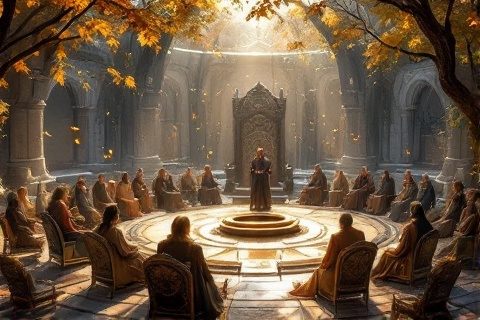
The Council of Elrond
Forging the Fellowship of the Ring
A Secret Council Assembles
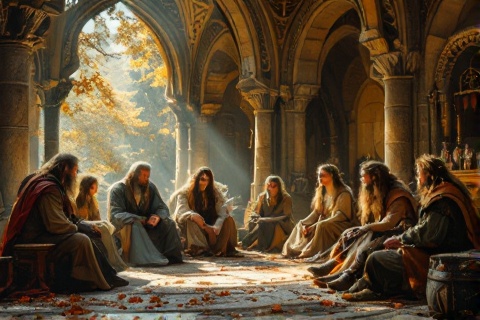
In the autumn of Third Age 3018, representatives from the free
peoples of Middle-earth converged upon the elven
sanctuary of Rivendell, also known as Imladris. The gathering occurred at a
critical moment as shadows lengthened across Middle-earth and rumors of war
spread throughout the lands.
Lord Elrond Half-elven, master of Rivendell and one of the wisest beings in
Middle-earth, called this secret council in response to growing evidence of
Sauron's return. Messages were sent to key allies and
representatives, though some arrived by chance or fate rather than summons.
The council assembled in Elrond's garden included an extraordinary mix of
Middle-earth's peoples: Elrond and his household, including Glorfindel; Gandalf
the Grey; Aragorn of the
Dúnedain; Boromir from Gondor; Legolas from the Woodland Realm;
Glóin and his son Gimli from Erebor; and the hobbits Frodo and
Bilbo Baggins.
The Tale of the Ring Unfolds
Lord Elrond began the council by recounting the ancient history of the One
Ring, starting with its forging by Sauron in the Second
Age and the subsequent War of the Last Alliance. His firsthand
account carried special weight, as he had been present at the battle where
Isildur cut the Ring from Sauron's hand but failed to destroy it.
Boromir, son of the Steward of Gondor, shared troubling news from the South
Kingdom. He described how Gondor stood as the primary bulwark against
Mordor's forces, with the garrison at Osgiliath under constant
assault and the shadow from the East growing ever darker. His words painted a
grave picture of his people's desperate struggle to maintain their defenses
against the Enemy's increasing strength.
The council received shocking news when Gandalf revealed the treachery of
Saruman the White, head of the White Council and greatest of the known wizards.
The wizard explained how Saruman had long studied the lore of the Rings of
Power and had ultimately been corrupted by his desire
to possess the One Ring, leading to his alliance with Sauron.
Frodo's Journey to Rivendell
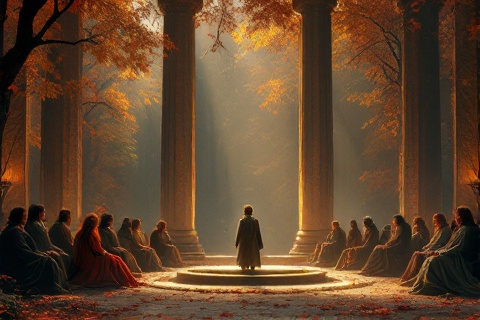
Gandalf provided a detailed explanation of why he had failed to meet Frodo as
planned at the start of his journey from the Shire. The wizard
recounted his discovery of Saruman's treachery and subsequent imprisonment atop
the tower of Orthanc, from which he escaped only through the aid of Gwaihir the
Windlord.
Frodo shared the harrowing tale of his flight from the Shire, beginning with
Gandalf's urgent instructions and the first appearance of the Black
Riders. His account included the group's encounters at the
Prancing Pony in Bree, their narrow escape on the Road, and their perilous
journey through the wilderness.
The council listened intently as the full extent of the Nazgûl's pursuit was
revealed, including their attacks at Weathertop and at the Ford of Bruinen. The
revelation that all Nine Ringwraiths had been sent to hunt for the Ring
demonstrated the Enemy's determination to reclaim his prize.
The tale of Aragorn's crucial role emerged, showing how the heir of Isildur had
protected the hobbits on their journey from Bree to Rivendell. His knowledge of
the wild lands and his skill in evading the Nazgûl had proved essential to their
survival, particularly after Frodo was wounded at Weathertop.
Bilbo's Ring Revealed
The council examined how Bilbo's magic ring, found in Gollum's cave decades
earlier, had been identified as Sauron's One Ring. The history of the Ring's
passage from Isildur to Gollum, and then to Bilbo through what seemed mere
chance, revealed the Ring's ability to work towards its own ends.
Gandalf described his painstaking research into the Ring's identity, including
his studies in Minas Tirith's ancient archives and his test of the Ring in
Frodo's fireplace, which revealed the fiery inscription in the Black Speech of
Mordor. The wizard's discoveries had confirmed their worst fears about the
Ring's true nature.
The council explored the full scope of the Ring's power and its corrupting
influence on all who possessed it. They discussed how it preserved and tormented
Gollum for centuries, extended Bilbo's life unnaturally, and how even the wise
and powerful would be corrupted if they attempted to wield it against Sauron.
The Shadow in the East

The gathered representatives shared intelligence about Mordor's increasing
military strength, including reports of armies massing behind the Black Gate and
the reconstruction of the Dark Tower of Barad-dûr. Scouts had observed increased
orc activity throughout the Misty Mountains and the spread of Sauron's influence
among the Easterlings and Haradrim.
Boromir provided a detailed account of Gondor's ongoing defense of the western
lands. He described the constant battles at Osgiliath, the last defense before
Minas Tirith, and spoke of how his people fought daily to prevent Mordor's
forces from gaining a foothold west of the Anduin River.
The council members shared their knowledge of Sauron's desperate search for the
Ring, noting how his servants had spread throughout Middle-earth seeking
information about 'Baggins' and the Shire. The Enemy's growing awareness of the
Ring's location added urgency to their deliberations.
The Treachery of Saruman
Gandalf shared the full tale of his imprisonment at Orthanc, describing how
Saruman had tried to persuade him to join forces with Sauron and help locate the
Ring. The wizard's account revealed the extent of Saruman's fall from wisdom
into pride and treachery.
The council learned how Saruman had gradually turned from his purpose, convinced
that alliance with Sauron was the only path to survival. His decades of study
into Ring-lore and his use of the palantír had ultimately
led to his corruption and betrayal of his original mission in Middle-earth.
Reports of Isengard's transformation into a fortress of war alarmed the council.
Gandalf described how Saruman had industrialized the ring of Isengard, building
forges and breeding grounds for his army of Uruk-hai, creating a second front in
the coming war.
Debate Over the Ring's Fate
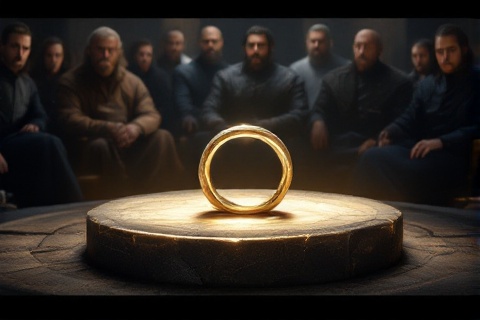
The council considered various proposals for handling the Ring, including
suggestions to hide it in the sea or send it over the western ocean to the
Undying Lands. Each possibility was carefully examined
and ultimately rejected as either temporary solutions or beyond their power to
achieve.
Through careful discussion, the council established that the Ring could not be
used as a weapon against Sauron, as it would corrupt anyone who tried to master
it. Even the wisest and most powerful among them, such as Gandalf and Elrond,
refused to take it, knowing they would be corrupted by its influence.
The council's deliberations led to the inescapable conclusion that the Ring must
be destroyed to defeat Sauron permanently. No other solution would prevent the
Dark Lord from eventually reclaiming his greatest weapon and completing his
conquest of Middle-earth.
The Path to Mount Doom
The council agreed that the only way to destroy the Ring was to cast it into the
fires of Mount Doom in Mordor, where it was originally forged. Elrond explained
that only in the Cracks of Doom could the Ring's adamantine strength be unmade,
as no lesser fire could harm the One Ring.
A detailed discussion of the journey's dangers revealed the near-impossibility
of the task. The path to Mordor would take the Ring-bearer through countless
perils, from the dangers of the wilderness to the armies of the Enemy.
The council examined the formidable defenses of Mordor, with its Black Gate
constantly guarded, the watchful Eye of Sauron scanning from Barad-dûr, and the
poisonous lands of Gorgoroth surrounding Mount Doom. The difficulty of entering
Mordor unseen seemed almost insurmountable.
Frodo Steps Forward
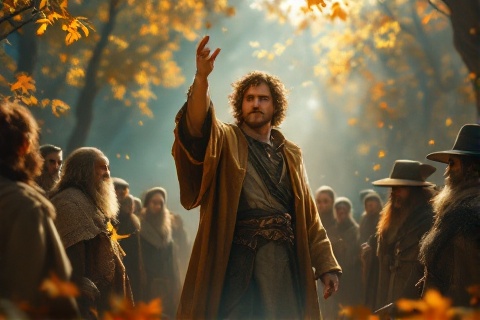
The council engaged in intense debate over who should undertake the perilous
mission to destroy the Ring. The great powers present, including Gandalf and
Elrond, recognized that sending a mighty lord or wizard would only hasten the
Ring's discovery, as they would be more easily corrupted by its power.
In a moment of profound courage and humility, Frodo Baggins stepped forward to
volunteer as Ring-bearer, offering to take the Ring to Mordor though he did not
know the way. His decision demonstrated the extraordinary resilience of hobbits
and their ability to resist the Ring's corruption longer than the great and
wise.
Gandalf and Aragorn immediately pledged their support to Frodo's quest,
recognizing both the hobbit's unique suitability for the task and his need for
guidance and protection. Their commitment marked the beginning of the formation
of a company to aid the Ring-bearer.
The Fellowship Forms
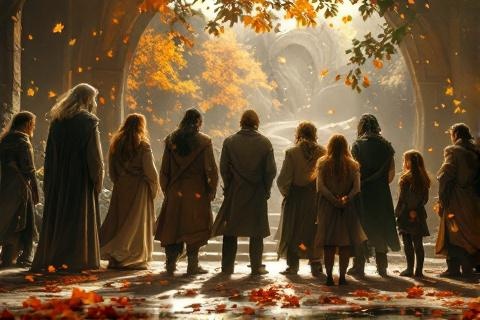
Eight companions were chosen to accompany Frodo on his quest: Gandalf as guide
and counselor, Aragorn and Boromir representing Men, Legolas for
the Elves, Gimli for the Dwarves, and Sam,
Merry, and Pippin for the Hobbits. Each member brought unique
skills and qualities that would prove vital to the quest.
The council noted the symbolic importance of having nine
companions to oppose the Nine Ringwraiths,
Sauron's deadliest servants. This balance of nine against nine represented hope
against terror, and freedom against slavery.
With the formation of the Fellowship of the Ring, the council concluded its
primary purpose. The nine walkers would depart from Rivendell as representatives
of the free peoples of Middle-earth, united in their quest to destroy the One
Ring and end Sauron's power forever.
